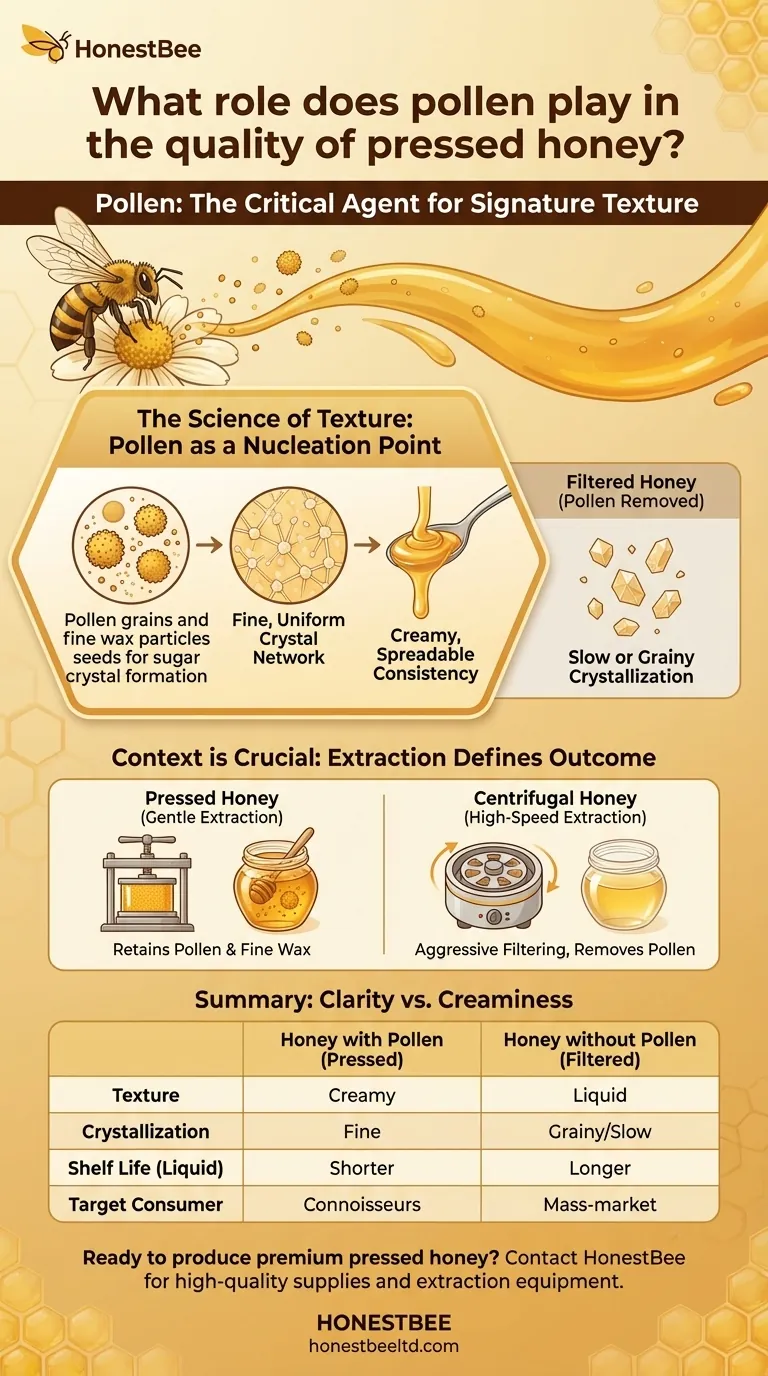In short, pollen is the critical agent that gives pressed honey its signature texture. While not a factor in food safety, the presence of pollen and fine wax particles serves as the catalyst for a smooth, fine crystallization process, creating the creamy, spreadable consistency that is highly valued by honey connoisseurs.
The central paradox of pollen in honey is this: while it doesn't define the honey's fundamental safety or nutritional quality, its presence is the very thing that creates the unique, creamy texture that distinguishes premium pressed honey from its more common liquid counterparts.

The Science of Texture: Pollen's Primary Role
The conversation about pollen in honey is fundamentally a conversation about texture. Its role is physical, not nutritional, acting as a structural architect for the final product.
Pollen as a Nucleation Point
Honey is a supersaturated sugar solution, which means it naturally wants to crystallize over time.
Pollen grains and other microscopic particles (like beeswax) act as nucleation points. These are the starting seeds around which sugar crystals begin to form.
With many of these small particles evenly distributed, crystallization happens uniformly throughout the honey, resulting in a network of very small, fine crystals.
The Impact on Mouthfeel and Quality
This process of fine crystallization is what prevents the formation of large, grainy sugar crystals that are often considered a defect in liquid honey.
The result is a smooth, thick, and creamy texture that is stable and spreadable. For many, this unique mouthfeel is the primary indicator of high-quality, traditionally processed pressed honey.
Context is Crucial: Impurity vs. Valued Ingredient
Whether pollen is viewed as a desirable feature or an unwanted impurity depends entirely on the honey's intended style and the extraction method used.
The Source of the Pollen
Pollen is a natural component of honey, brought back to the hive by bees along with nectar.
However, honey extracted from combs that have also been used for raising bee larvae (brood combs) will contain significantly more pollen and other particles. This is why a beekeeper's methods are so important.
Extraction Method Defines the Outcome
Pressed honey is made using a gentle extraction technique that squeezes the honey from the comb. This process inherently retains more of the natural pollen and fine wax particles.
This contrasts sharply with centrifugal extraction, a high-speed process that flings honey out of the comb. This method often requires more aggressive filtering to achieve the clear, liquid product most consumers expect.
Understanding the Trade-offs: Clarity vs. Creaminess
The decision to retain or remove pollen comes down to a choice between two different ideals for the final product.
Why Most Commercial Honey is Filtered
The mass-market preference is for honey that is visually clear and remains liquid on the shelf for as long as possible.
Aggressive filtering removes the pollen "nucleation points," which significantly slows the natural crystallization process. This ensures a consistent, liquid product but sacrifices the potential for a creamy texture.
The Benefit of Retaining Pollen
Producers of pressed honey intentionally retain pollen to achieve that signature creamy consistency.
This is a deliberate choice that prioritizes texture and traditional character over clarity and a long liquid shelf life. It caters to a different consumer—one who appreciates honey in its more natural, crystallized state.
Making the Right Choice for Your Goal
Ultimately, the ideal honey depends on your personal preference for texture and appearance.
- If your primary focus is a smooth, creamy, and spreadable honey: Seek out pressed honey, where the natural pollen content is intentionally preserved to guide its crystallization.
- If your primary focus is a clear, liquid honey for drizzling: Choose a highly filtered, often centrifugally extracted honey where pollen has been removed to delay crystallization.
- If your primary focus is food safety or basic nutrition: The presence or absence of pollen is not a determining factor in the quality or safety of the honey.
Understanding the role of pollen empowers you to choose honey based on its intended character and texture.
Summary Table:
| Aspect | Honey with Pollen (Pressed) | Honey without Pollen (Filtered) |
|---|---|---|
| Texture | Smooth, creamy, spreadable | Clear, liquid, drizzle-able |
| Crystallization | Fine, uniform crystals | Slow or large, grainy crystals |
| Shelf Life (Liquid) | Shorter | Longer |
| Target Consumer | Connoisseurs, traditionalists | Mass-market, general use |
Ready to produce premium pressed honey with the perfect creamy texture?
At HONESTBEE, we supply commercial apiaries and beekeeping equipment distributors with the high-quality supplies and extraction equipment needed to master traditional methods like honey pressing. Our wholesale-focused operations ensure you get the reliable tools to create a product that stands out in the market.
Contact our experts today to discuss how our solutions can help you achieve the signature quality that honey connoisseurs value.
Visual Guide

Related Products
- Professional Long-Handled Silicone Honey Scraper for Beekeeping
- Professional Wide Blade Honey Scraper for Beekeeping and Honey Processing
- Professional Galvanized Hive Strap with Secure Locking Buckle for Beekeeping
- Retractable Chinese Queen Rearing Grafting Tools Equipment
- HONESTBEE Professional Bee Frame Machine for Side Bar Shaping
People Also Ask
- What is honey uncapping? The Essential First Step to Harvest Your Honey
- What other tools are available for honey uncapping besides knives? Find the Right Tool for Your Apiary's Scale
- Why is uncapping necessary in honey harvesting? Unlock Your Honey Yield & Preserve Comb
- What type of bees are better adapted to certain climatic conditions? Match Bee Strategy to Your Climate for Success
- How much time does it take to do beekeeping? A Realistic Breakdown for Beginners & Pros



















